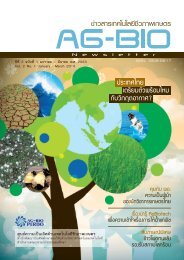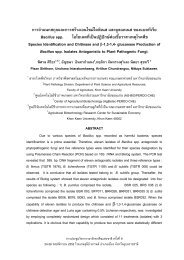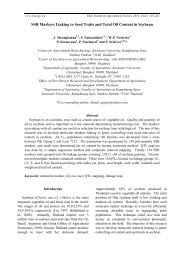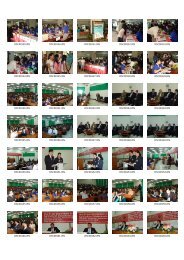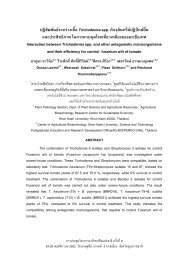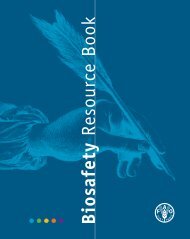Biosafety Manual PDF - Lawrence Berkeley National Laboratory
Biosafety Manual PDF - Lawrence Berkeley National Laboratory
Biosafety Manual PDF - Lawrence Berkeley National Laboratory
You also want an ePaper? Increase the reach of your titles
YUMPU automatically turns print PDFs into web optimized ePapers that Google loves.
<strong>Biosafety</strong> <strong>Manual</strong><br />
IBC-approved version (May 18, 2010)<br />
In the food industry, the term sanitization has a more specific meaning. According to the<br />
California Retail Food Code (CRFC), sanitization means the application of cumulative heat or<br />
chemicals on cleaned food-contact surfaces that, when evaluated for efficacy, is sufficient to<br />
yield a reduction of five logs, which is equal to a 99.999% reduction, of representative disease<br />
microorganisms of public health importance.<br />
F.2.1.4 Antisepsis<br />
Antisepsis is the application of a liquid antimicrobial chemical to human or animal living tissue.<br />
The purpose of antisepsis is to prevent sepsis by destroying potentially infectious organisms or<br />
by inhibiting their growth and multiplication. Sepsis is the presence of infectious organisms in<br />
the blood or other tissue of the body. No sporicidal activity is implied. Examples of antisepsis<br />
include application of a germicide to the injection site on a research animal, and handwashing<br />
with germicidal solution. With handwashing, the objective includes preventing the spread of<br />
infectious or contaminating agents for safety and quality control.<br />
F.2.2 Antimicrobial Categories<br />
Chemical or physical agents or substances that can decontaminate under ideal conditions have<br />
specific terms with specific meanings. The broadest term for such agents is the term<br />
antimicrobial. Antimicrobial is a chemical or physical agent that can prevent microbial growth<br />
either by some static action or by the direct killing of microbes. Categories of antimicrobials<br />
include:<br />
• Sterilant. An antimicrobial chemical or physical agent that is capable of killing all<br />
microbes including their spores to the sterility assurance level.<br />
• Germicide. An antimicrobial substance or physical agent that kills microbes. Germicides<br />
are a broader category of antimicrobials than disinfectants, since some germicides are<br />
active against endospores and viruses. Germicides, which are also known for the<br />
specific microorganisms they kill, end with the suffix –cidal (e.g., bacteriocide, sporicide,<br />
fungicide, virucide).<br />
• Disinfectant. A chemical germicide or physical agent that is applied to inanimate objects<br />
to kill microbes, but is not capable of killing endospores, some viruses, or<br />
mycobacterium. Disinfectants are typically chemical germicides.<br />
• Antiseptic. A disinfecting chemical agent applied to living tissue and used to prevent<br />
sepsis. Antiseptics are a subset of disinfecting chemical agents. A few agents are<br />
suitable as both disinfectants and antiseptics, although most disinfectants are too harsh<br />
for use on delicate skin.<br />
F.2.3 Antimicrobial Selection and Registered Disinfectants<br />
When using a chemical or physical antimicrobial to ensure decontamination is accomplished for<br />
biosafety purposes (i.e., protection of workers, public, agriculture, or environment):<br />
• There should be information indicating that the selected antimicrobial will be effective<br />
when used in a certain manner for the biological materials or agents and equipment or<br />
surfaces that need to be decontaminated; and<br />
• The antimicrobial should be used in accordance with its antimicrobial activity capabilities<br />
and conditions of use.<br />
Printed copies are not official versions of this manual. Before using the printed copy, verify that it is the most current version.<br />
141



